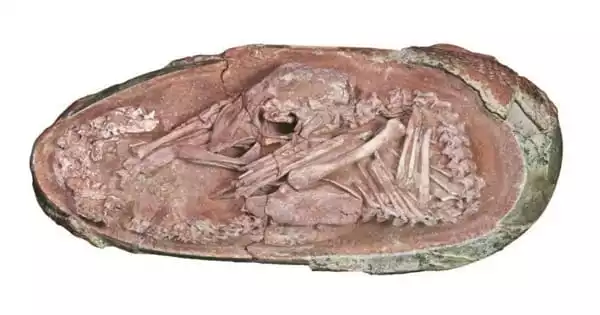Scientists have discovered a perfectly preserved dinosaur embryo that was about to hatch from its egg, just like a chicken. The embryo was discovered in Ganzhou, China, and scientists believe it is at least 66 million years old. According to a new study, a 72 to 66-million-year-old embryo discovered inside a fossilized dinosaur egg sheds new light on the link between modern birds and dinosaur behavior.
The embryo, dubbed ‘Baby Yingliang,’ was discovered in the Late Cretaceous rocks of Ganzhou, southern China, and belongs to an oviraptorosaur, a toothless theropod dinosaur. The fossil, which is one of the most complete dinosaur embryos ever discovered, suggests that these dinosaurs developed bird-like postures close to hatching.
Scientists discovered that ‘Baby Yingliang’ has a posture that is unique among known dinosaur embryos: its head is below the body, with feet on either side and the back curled along the blunt end of the egg. This posture, previously unknown in dinosaurs, is similar to that of modern bird embryos.
In modern birds, such postures are related to ‘tucking,’ a central nervous system-controlled behavior that is critical for hatching success. Researchers believe that such pre-hatching behavior, previously thought to be unique to birds, may have originated among non-avian theropods after studying egg and embryo.
Dinosaur embryos are some of the rarest fossils, and most of them are incomplete with the bones dislocated. We are very excited about the discovery of ‘Baby Yingliang,’ which has been preserved in excellent condition and will help us answer many questions about dinosaur growth and reproduction.
Fion Waisum Ma
The research team from China, the United Kingdom, and Canada, led by scientists from the University of Birmingham and the China University of Geosciences (Beijing), published its findings today in the journal iScience.
The egg was discovered in 2000, but it was not discovered for another ten years. Only when construction on the museum began and old fossils were being sorted through did researchers turn their attention to the egg, which they suspected was carrying an embryo inside. A portion of the dinosaur’s body is still covered by rock, and researchers will use advanced scanning techniques to create an image of its entire skeleton.
The embryo is articulated in its life position with little disruption due to fossilization. The creature is estimated to be 27 cm long from head to tail and is nestled inside a 17-cm-long elongatoolithid egg. The specimen is on display at the Yingliang Stone Nature History Museum.
“Dinosaur embryos are some of the rarest fossils, and most of them are incomplete with the bones dislocated,” said Fion Waisum Ma, co-first author and Ph.D. researcher at the University of Birmingham. We are very excited about the discovery of ‘Baby Yingliang,’ which has been preserved in excellent condition and will help us answer many questions about dinosaur growth and reproduction.

“It’s interesting to see how this dinosaur embryo and a chicken embryo pose in the egg in a similar way, which could indicate similar prehatching behaviors.”
‘Baby Yingliang’ was identified as an oviraptorosaur based on its deep, toothless skull. Oviraptorosaurs are a group of feathered theropod dinosaurs that lived in Asia and North America during the Cretaceous period and are closely related to modern birds. Their variable beak shapes and body sizes allowed them to eat a variety of diets, including herbivory, omnivory, and carnivory.
Soon before hatching, birds are known to develop a series of tucking postures in which they bend their body and bring their head under their wing. Embryos that do not achieve such postures have a greater chance of dying due to unsuccessful hatching.
The team proposed that tucking behavior, which was thought to be unique to birds, first evolved in theropod dinosaurs many tens or hundreds of millions of years ago by comparing ‘Baby Yingliang’ with the embryos of other theropods, long-necked sauropod dinosaurs, and birds. Additional discoveries of embryo fossils would be extremely valuable in testing this hypothesis.
“This dinosaur embryo was acquired by the director of Yingliang Group, Mr Liang Liu, as suspected egg fossils around the year 2000,” said Professor Lida Xing of China University of Geosciences (Beijing), co-first author of the study. During the construction of the Yingliang Stone Nature History Museum in the 2010s, museum staff sorted through the storage and discovered the specimens. These specimens were identified as dinosaur egg fossils. Fossil preparation was carried out, which eventually revealed the embryo hidden inside the egg. This is how ‘Baby Yingliang’ became known.”
Professor Steve Brusatte of the University of Edinburgh, who was a member of the research team, stated: “One of the most beautiful fossils I’ve ever seen is a dinosaur embryo inside its egg. This tiny prenatal dinosaur resembles a baby bird curled in its egg, providing further evidence that many characteristics of modern birds evolved in their dinosaur ancestors.”





